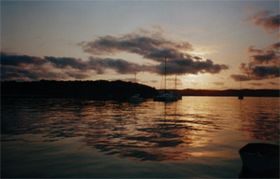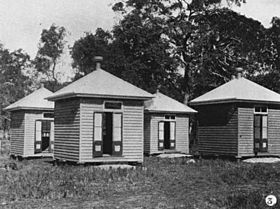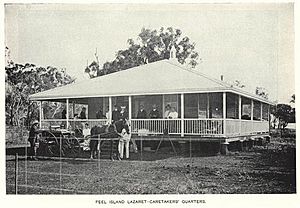Peel Island facts for kids
|
Native name:
Teerk Roo Ra
|
|
|---|---|

Sunrise at Horseshoe Bay, Peel Island
|
|
| Geography | |
| Location | Moreton Bay |
| Coordinates | 27°30′S 153°21′E / 27.500°S 153.350°E |
| Area | 590 ha (1,500 acres) |
| Length | 1 km (0.6 mi) |
| Width | 3 km (1.9 mi) |
| Administration | |
|
Australia
|
|
| State | Queensland |
| Region | South East Queensland |
| Local government area | Redland City |
| Peel Island Queensland |
|||||||||||||||
|---|---|---|---|---|---|---|---|---|---|---|---|---|---|---|---|
| Population | 0 (2016 census) | ||||||||||||||
| • Density | 0/km2 (0/sq mi) | ||||||||||||||
| Postcode(s) | 4184 | ||||||||||||||
| Area | 12.4 km2 (4.8 sq mi) | ||||||||||||||
| Time zone | AEST (UTC+10:00) | ||||||||||||||
| LGA(s) | City of Redland | ||||||||||||||
| State electorate(s) | Oodgeroo | ||||||||||||||
| Federal Division(s) | Bowman | ||||||||||||||
|
|||||||||||||||
| Peel Island | |
|---|---|

Huts constructed for patients on Peel Island, Moreton Bay, 1907
|
|
| Built | 1870s–1960s |
| Owner | Queensland Parks and Wildlife Service |
| Official name: Peel Island, Moreton Bay | |
| Type | Health and care services: Lazaret/leprosarium |
| Criteria |
|
| Designated | 21 June 1993 |
Peel Island is a small, historic island in Moreton Bay, east of Brisbane, Australia. Its traditional name in the Indigenous Janday language is Teerk Roo Ra, which means 'Place of Many Shells'. The island is part of Redland City and is also a national park. In 2016, no one lived on Peel Island.
You can only reach Peel Island by boat. The waters around the island are home to dugongs, sea turtles, and dolphins. You might also see many jellyfish and even sharks here. Horseshoe Bay is a popular spot for boaters, with its sandy beach and calm waters. It's a great place for sailors to anchor overnight. Sea kayakers also enjoy staying on the island. Peel Island is known for its beautiful natural environment, with many birds and animals living undisturbed. Over 70 different kinds of birds have been seen on the island.
Many of the old buildings from the island's past are still standing today. This is because the island is isolated and access is limited, which helps protect them. The Queensland Parks and Wildlife Service has looked after the island since 1992. They have worked to fix up some of the main buildings and make the island safe for visitors.
Contents
Exploring Peel Island's Geography
Peel Island is located in the southern part of Moreton Bay on Australia's east coast. It is about 20 kilometers from Brisbane and 6 kilometers from the town of Cleveland. The island sits between Cleveland Point and Dunwich, which is on North Stradbroke Island. Around Peel Island, you'll find mudflats, seagrass, coral reefs, and mangroves.
The island covers about 400 hectares. It is about 1 kilometer long from north to south and 3 kilometers wide from east to west. Horseshoe Bay, on the southern side, has clean, calm waters perfect for swimming.
Peel Island's Past: A Place of Isolation
From 1907 to 1959, Peel Island was used as a lazaret. A lazaret was a special place to isolate people with leprosy, also known as Hansen's disease. This part of Peel Island's history is important because it shows how health policies worked in Queensland and reminds us of the tough conditions people faced there.
Why Was Peel Island Used as a Lazaret?
Leprosy came to Australia with new migrants after free settlement. Because of this, the Queensland government passed the Leprosy Act of 1892. This law made it possible to isolate people with leprosy away from the mainland.
Before 1907, Peel Island had other uses. Indigenous Australians lived on the island for a long time, using it for important gatherings and ceremonies. Archaeological studies have found evidence of their presence, like shell middens. In the 1800s, the New South Wales government used Peel Island as a quarantine station. It held people who were not considered suitable for general society.
Later, it became a place for people with alcohol problems, and then, in 1907, a lazaret. There were already two lazarets in Queensland, on Friday Island and at Dunwich. But these were closed because of problems with conditions and patient care. Peel Island was chosen as the new, permanent lazaret.
Life and Conditions at the Lazaret
Life on Peel Island was very difficult, especially in the early years. Being isolated on the island felt more like being in prison than a hospital. Many patients were taken from their families without warning or a chance to say goodbye. Some were even chained by police before being sent to the lazaret. There are stories of patients being towed behind a ship in a small boat on their way to the island.
Once there, patients tried to get help from outside the island to improve their terrible living conditions. The lazaret was designed for isolation, so each patient lived in their own hut. These huts were grouped into three areas based on gender, race, and how severe their illness was. Each area was surrounded by tall, 8-foot wire fences, which were locked at night.
A typical hut had a bed, a chest of drawers, a table, and a chair. Later, awnings were added to protect patients from the weather. Other buildings on the island included a kitchen, dining room, bathhouses, and homes for nurses and staff. For many years, patients who died on the island had to be buried there. The site is still preserved today, reminding us of the harsh conditions.
Daily Life and Challenges
Boredom was a big problem for patients on Peel Island. Staff could leave the island, but patients were stuck there, often for many years, with no idea when they might leave. To pass the time, many patients, mostly men, would go fishing or do some gardening. Later, patients had radios, and sometimes movies were shown or dances were organized for everyone. Some patients and staff even got married over the years. Staff often went to Horseshoe Bay to relax on the beach.
Even though the Queensland Government insisted on isolating people with Hansen's disease, the lazaret often lacked enough funding. This led to problems like poor food, not enough medical treatment, and buildings that weren't kept up. These issues made patients and staff feel even more isolated.
In 1908, an Anglican Church was built for patients. In 1925, the island got its first medical facility, and a hospital building in 1937. It took 20 years after the lazaret opened for a surgery building to be built. Electricity didn't arrive on the island until 1948, 17 years after it was available on the mainland.
Unfair Treatment: Racial Discrimination
There were big differences in how non-white patients (like Indigenous Australians, Torres Strait Islanders, South Sea Islanders, and Chinese Australians) were treated compared to European Australians. When leprosy reappeared in the world, it was often wrongly linked to race, showing the unfair attitudes of the time.
Earlier lazarets had separated white and non-white patients. But on Peel Island, both groups were held together for the first time in Queensland. This made the unfair treatment even more obvious. The lazaret was divided into separate areas for white and non-white patients. The living spaces and facilities for non-white patients were much worse.
For the first three years, non-white patients had no cooking or washing facilities. Their huts were much lower quality than those for white patients. Non-white patients had to carry their own firewood and water, while white patients had theirs provided. An inquiry in 1908 found that non-white patients received half the amount of meat, butter, and tobacco as white patients. They also didn't get beer or tapioca.
Many non-white patients lived in tents until their huts were built. These early huts were made of corrugated iron with dirt floors that turned to mud when it rained. Windows were just holes cut into the walls. Often, two patients shared a hut designed for one. These harsh conditions made many non-white patients very sick and likely led to a higher death rate among them.
During World War II, resources became limited. In 1940, all 50 non-white patients on Peel Island were sent to Fantome Island. By 1945, 40 of them had died from tuberculosis, raising questions about their treatment. Even though authorities knew about the unfair conditions as early as 1912, improvements for non-white patients didn't happen until much later.
Patients and Staff Stories
When the lazaret opened in 1907, there were 71 patients. Over 500 patients lived on Peel Island during its 52 years of operation. Nearly 200 of them died there. Others got better and left, but some had to return if their illness came back.
Patients on Peel Island did not agree with being isolated. In 1926, 35 patients asked the Premier of Queensland to change the laws. They wrote: "There are patients who would astound you by their fine healthy appearance, still they are held in segregation by the cruel and unjust law in existence." It took another 33 years for the lazaret to close.
For many years, Peel Island had too few staff. It was hard to find nurses, doctors, and maintenance workers because of the negative ideas about Hansen's disease and fears that it was very contagious. The island didn't have a resident doctor until 1946. Before that, a doctor only visited once a week to provide basic medical care.
- Rosemary Opala was a nurse at the Peel Island Lazaret. She wrote and created art about the lazaret's history, the unfair ideas about the disease, and the controversial treatment of patients. She also helped document and promote Peel Island's natural environment.
- Noel Laddie Agnew was diagnosed with Hansen's disease at age 8. He was one of the patients moved to Peel Island in 1907. During his time there, Noel observed and listed over 75 species of birds on the island. His lists were published in a journal called The Emu in 1913 and 1921. Noel died on Peel Island at 41, after the disease affected his limbs and eyes.
- June Berthelsen was another patient, diagnosed in 1956. Her book, The Lost Years: A Story of Leprosy, shares her experiences on the island from 1956 to 1958. It describes daily life, her relationships with staff, and how women patients didn't receive a pension, unlike men.
New Treatments and Hope
Early treatments for Hansen's disease included injections of a drug called nastin, and later, oil from the Chaulmoogra nut. This oil was often painful, and its long-term benefits were unclear, but it was used for over 30 years. Many doctors believed that a good diet and a stress-free lifestyle were more likely to help patients get better.
In January 1947, patients on Peel Island received new drugs called sulfone derivatives. These drugs, developed in the United States, were very successful. From then on, Hansen's disease became much easier to treat.
The End of Isolation
The new treatments for Hansen's disease in the 1940s meant that isolating patients was no longer necessary. So, in 1959, the lazaret on Peel Island officially closed. The last ten patients were moved to the Princess Alexandra Hospital in Brisbane to finish their treatment. By this time, many of the old negative ideas about Hansen's disease had faded. Today, there are several drugs that can treat symptoms like nerve damage and prevent the disease from spreading. Researchers are also working on vaccines to prevent the disease and improve early detection.
Peel Island Lazaret Today
Because Peel Island is isolated and access is limited, many of the original lazaret buildings are still standing in good condition. This allows visitors to see a rare example of a 20th-century institution. However, access is restricted to help protect these historic remains. The Queensland Parks and Wildlife Service has managed the park since 1992. They have worked to restore key buildings and make the island safe for future visitors.
Peel Island's Heritage Status
Peel Island is recognized for its important cultural heritage. In 1993, it was added to the Queensland Heritage Register and the former Register of the National Estate. In December 2007, Peel Island was officially named Teerk Roo Ra (Place of Many Shells) National Park and Conservation Park.
Images for kids
-
Peel Island is located between North Stradbroke Island and Cleveland.




